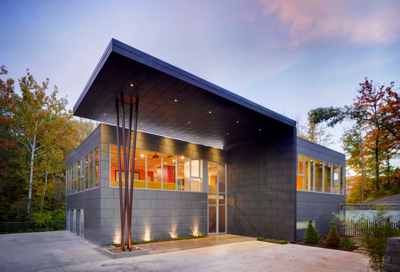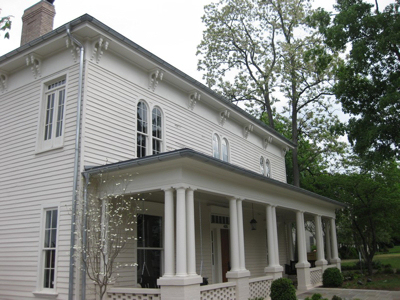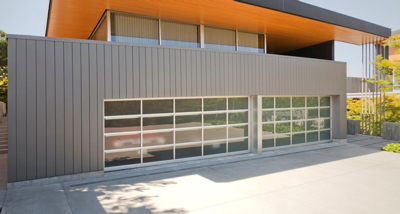Architectural Zinc In Residential Applications: Why More Homes Will Include Zinc As A Durable, Green Building Material
By Kim Weiss, Blueplate PR
 | |
The GREENville House by Tonic Design, an excellent example of the use of architectural zinc in an eco-friendly, energy-saving home, features VMZinc Quartz-zinc in a flat lock aspect. Click image to enlarge. |  |
Sustainable or “green” buildings – buildings that are deliberately designed to use natural resources in a way that’s environmentally friendly – are no longer a luxury. They are an imperative.
Consider the facts: According to the National Institute of Building Sciences’ Whole Building Design Guide, “On an annual basis, buildings in the United States consume 39 percent of America's energy and 68 percent of its electricity. Furthermore, buildings emit 38 percent of the carbon dioxide (the primary greenhouse gas associated with climate change), 49 percent of the sulfur dioxide, and 25 percent of the nitrogen oxides found in the air. Currently, the vast majority of this energy is produced from nonrenewable, fossil fuel resources...”
Of the two ways to reduce heating, cooling and lighting loads “through climate-responsive design and construction practices,” the Whole Building Design Guide recommends the use of “high-performance building envelopes: select walls, roofs, and other assemblies based on long-term insulation, and durability requirements.”
One of the most sustainable, high performance building materials prevalent throughout the world is zinc.
| |  |
 | A house in Cincinnati designed by Jose Garia features sheet metal panel, Dri-Design cassette aspect, in VMZ Quartz-zinc and Anthra-zinc. Click image to enlarge. |
Zinc is reported to be the 23rd most abundant element in the earth's crust. It is a non-ferrous metal that is not susceptible to rust or corrosion: It’s weatherproof, seismic proof, corrosion resistant, and immune to the harmful effects of UV rays, ensuring a very long service life without degradation.
This is possible because architectural zinc develops its own protective layer, which is called zinc hydroxyl-carbonate. Once it’s formed, that layer blocks moisture and chemicals from penetrating the zinc and, if it’s scratched, the hydroxyl-carbonate will reform over time. In other words, zinc heals itself. That’s why zinc walls and roofs last on average from 80 to 100 years.
Zinc also requires very little energy to manufacture and little to no maintenance, and it is 100 percent recyclable from new construction scrap to the time it reaches its end use. As a result, zinc roofs and wall cladding never end up in landfills.
For generations, European architects have specified zinc as a building envelope material for all types of buildings because it would last and endure harsh weather conditions. In the late 1700s, zinc was also one of the most popular materials used for roofing in America, which is why many well-known historic structures, such as the Washington Monument and Thomas Jefferson's Monticello, had metal roofs.
Unfortunately, zinc fell out of favor in the U.S. as less expensive roofing materials evolved, such as asphalt shingles, and as American developers and building owners lapsed into a “throw-away” mind-set in the 1960s and ‘70s that still assumes no more than a 30- to 50-year life span for American buildings.
Today, American architects are becoming more enamored with the material, not only for its durability but also because of the increasing need for environmentally sustainable design and construction.
American architects are warming to the use of zinc on commercial, institutional, and government buildings. A few far-sighted practitioners are also encouraging their residential clients to use architectural zinc on their homes – from brand-new construction to renovation and historic restoration.
New Construction: Thinking of The Future
“Zinc ultimately costs much less than asphalt shingles when you calculate the life span of the house,” says Daniel Nicely, director of market development for VMZINC® and an associate member of the American Institute of Architects (AIA). “Shingles are usually composed of asphalt, a decidedly non-green material, and an average shingle roof will need to be replaced about every 10 years -- four to five times compared to the lifetime of one zinc roof.”
Compared to other metals that may be less expensive than zinc (painted aluminum, for example) or more expensive (copper), Nicely insists that zinc comes out ahead in analysis. He points out:
• Painted materials can scratch and will rust if they’re not protected or if they’re damaged, and their life span is half to one-third that of zinc’s.
• Copper now costs roughly twice as much as zinc.
• Some communities have raised concerns about the run-off from copper. Zinc’s run-off is clear and will not stain adjacent materials, as copper will.
• More zinc is found naturally in the soil than will ever run-off a typical residential roof.
• Zinc becomes non-bio-available once it hits the ground so it does not pose any threat to children or pets.
• Ceramic tiles and slate are heavier than zinc and require a stronger, more expensive structural base than zinc.
 | |
For a historic home at Lake Geneva, architects McCormack+Etten specified rainwater goods in VMZ Quartz-Zinc. Click image to enlarge. | |
 |  |
The Cooper House features European-style gutters and seamless weld downspouts manufactured in natural VMZINC® by Ornametals Manufacturing of Cullman, Alabama. Click image to enlarge. | |
A zinc roof is also more energy efficient than less-expensive asphalt shingles because it reflects heat and blocks heat transfer into attics. Research by the Florida Solar Energy Center back in 1985 proved that metal roofs in general absorbed 34 percent less heat than asphalt shingles, and homeowners switching to metal roofing reported saving up to 20 percent on their energy bills.
In Greenville, North Carolina, the Walters Residence, a sleek, modern residence designed by Tonic Design + Build, is an excellent example of the use of architectural zinc in an eco-friendly, energy-saving home. Both the clients and the design team envisioned the house as a model of environmental sensitivity and materials selection was critical to their success. To that end, designer Vincent Petrarca, Associate AIA, specified 1500 square feet of VMZINC flat lock panel for the home’s double-height “public” space.
“The color, material qualities, and the system of interlocking panels created a detailed texture of surface and shadow on the exterior facade of the two-story public space of the house,” said Petrarca. “In order to meet the goals of a LEED for Homes Silver project, we selected zinc as a key feature in the exterior composition of materials. Not only is it 100 percent recyclable, but it’s also durable and low maintenance with a lifespan of nearly 100 years. This was very appealing to the clients.”
The “GREENville House,” as its architects call it, is now a LEED for Homes Silver Certified and Energy Star-rated home and was featured in Architectural Record in April of 2010. The project also won a 2010 AIA NC COTE (Committee on the Environment) Environmental Design Award, and this year received a Chairman’s Award from the Metal Constructors Association (www.metalconstruction.org). The judges for the latter “applauded the choice to use zinc, given the sustainable characteristics the builder was going for.”
As in the Greenville house, aesthetics are also an issue for designers, who see zinc roofs and cladding as a sustainable product that’s applicable to both modern and traditional styles, and that blends beautifully with other building materials. Zinc sheeting is highly malleable so it can conform to a variety of architectural styles, both angular and curved. Zinc panels are manufactured in a host of shapes, from undulating waves to parallel ridges and interlocking hexagons, thus adding another artistic element to a home’s roof or overall envelope.
In his blog “Life Of An Architect,” Dallas, Texas-based architect Bob Borson, noted in August of 2011: “Despite the fact that zinc is metal, there is an amazing visual and physical softness to it.” When he wrote that post, he was waiting to see the installation of zinc standing seam metal panels on a modern, infill housing project he’d designed. “We are actually using two different colors on this job,” he said, “a beautiful grey zinc called Quartz and a mind-exploding black zinc called Anthra.” Both are VMZINC® products by Umicore.”
In New Caanan, Connecticutt, architects Joeb Moore + Partners combined zinc and cedar cladding to create a 5300-square foot house “incorporating contemporary and green technologies and products.” The exterior of the three-level house is dramatically enlivened by the juxtaposition of charcoal-gray zinc and the warm, honey-colored tones of the cedar siding. (www.freshome.com)
Residential Renovation
Renovation is a growing segment in residential zinc applications. Many antebellum homes in the United States had tin or lead roofs. Replacing them with zinc maintains the look of the original materials with the modern benefit of sustainability and a lifetime worth of low maintenance shelter from the elements.
“As more homeowners choose quality and sustainability over initial cost in home renovations, they’re choosing zinc over other materials,” said Nicely, who noted that residential renovation building products is becoming a standard part of VMZINC’s business. “We’ve seen zinc used for small homes and porches as well as large estate homes. It’s often selected for fireplace surrounds and kitchen counters, as well, along with rainwater goods.”
Ornamentals Manufacturing LLC is featuring VMZINC rainwater goods in its 2011 EuroGutterUSA product offering. The company manufactures a complete rainwater system including half-round gutter, seamless-weld downspouts, and all accessories in natural VMZINC®, QUARTZ-ZINC® and ANTHRA-ZINC®.
“VMZINC rainwater goods are a popular choice for those who prefer grey-to-charcoal shades to match the rest of the house,” said Guenther Huber, president of Ornametals. “We’re finding that more and more people prefer the look of zinc, especially given its high-quality and durability.”
Historic Restoration: Lasting Value for Heritage Homes
“A bird's-eye view of Paris shines with the natural patina of zinc,” wrote TLC’s Cristin Conger in an article entitled “Is Zinc The New Green Standard For Building?” She goes on to say: “In the late 1800s, zinc was the material of choice for Parisian rooftops. Once metallurgists honed the process of smelting zinc into sheets, the metal became popular particularly in Belgium, France and Germany. Two hundred years later, some of those original roofs still crown the historic buildings.”
Zinc is a viable and non-toxic choice for historic/heritage homes that are intended to last forever as part of a nation’s architectural heritage – as Europeans have readily embraced and early American designers and builders, including Thomas Jefferson, recognized. A roof that can last up to 100 years, basically maintenance free, seems an obvious choice for a historic home, especially since today's metal alloy has been standardized and improved upon and is, therefore, assumed to be an even more durable product than ever before.
“An 80- to 100-year life span makes zinc a legacy material,” noted VMZINC’s Dan Nicely. “A home with zinc is designed to last generations.”
| |  |
 | To maintain the historical look of the house, the architectural firm managing the site chose natural VMZINC® for its historically correct gray color, strength, and durability. Click image to enlarge. |
In a guideline for choosing roof materials and repairs for historic buildings in the United States, published in The Old House Journal, Sarah Sweetser of the National Trust of Historic Preservation stresses, “A poor roof will permit the accelerated deterioration of historic building materials -- masonry, wood, plaster, paint -- and will cause general disintegration of the basic structure.”
In 2006, John Leeke, preservation consultant for Historic Home Works.com of Portland, ME, wrote during a conference on roofing repairs in post-Katrina New Orleans: “It is my experience that long-term damage too often results when modern building materials are introduced into historic buildings.”
The value of zinc’s low maintenance factor was underscored at the University of North Carolina at Greensboro when the decision was made to use zinc for two projects there, including the Hall for Humanities Research and Administration. The university acknowledged that construction budgets tend to be well funded but maintenance budgets are not. The self-healing characteristic of zinc was another factor in the decision, as was aesthetics:
“Zinc worked well because of the appearance,” said Andy Sykes of Calloway Johnson Moore & West, PA, in North Carolina, project manager for the Hall for Humanities’ project. “The color was more similar to what historical turn-coated lead roofs looked like and blended with the traditional campus roofs." (source: McGraw-Hill Construction, Continuing Education Center)
 | |
A house on Mercer Island designed by E. Cobb Architects Inc. VMZ Interlocking panels in Anthra-Zinc. Click image to enlarge. |  |
The aesthetic quality of architectural zinc for historic buildings was a key issue for the Central Presbyterian Church in Huntsville, Alabama, when it renovated the Cooper House, a nearby antebellum house that is listed on the National Register of Historic Places, to become its new Family Life Center. The old house needed a new roof and rainwater system that would be consistent with the house’s historic style and last well into the future.
Hays Buchanan, the architects on the church project, chose natural VMZINC® “for its historically-correct gray color, strength and durability,” reported DesignandBuildwithMetal.com recently.
While zinc is often used in contemporary applications, the Cooper House project is a perfect example of why it is a natural choice for historic restoration: the color, in this case of natural VMZINC, is historically correct aesthetically pleasing, durable and intended to last for decades. In addition, production techniques allow it to maintain the unique look of natural metal with consistent colors. Natural VMZINC will not develop a drastically different patina like copper, for example, that changes from its copper color to green. Instead, it weathers over the years to form a textured gray patina.
DesignandBuildwithMetal.com also reported that Central Presbyterian church leaders and the Huntsville/Madison County Historical Society “readily approved the application [of zinc roofing and rainwater system] as consistent with the building’s historical architecture.”
Will Residential Use of Zinc Sweep America?
After rhapsodizing over the beauty, value, and sustainability of architectural zinc, Dallas architect Bob Borson answered the question he knew his blog readers would ask: Why isn’t zinc used more in residential design?
“The reason we don’t use it more often is because of the price,” Borson wrote. “For the average standing seam profile, material cost and labor will run you in the ballpark of $20 per square foot.”
For a young family building their first home, or senior citizens replacing the roof of a home they’ve already lived in for over 50 years, the cost is understandably prohibitive. But for new, modern homes from North Carolina to California, elegant estates in the North East or Pacific Northwest, a mid-century or old farmhouse renovation in Florida or Kentucky, or a historic home in the heart of Charleston, Savannah, New Orleans’ French Quarter, et al, the durability and sheer beauty of zinc roofing and wall cladding will continue to gain popularity as the imperative for sustainable, energy-saving homes grows stronger.
About VMZINC®
 VMZINC® is the international brand name of rolled zinc products manufactured and sold VM Building Solutions USA. For additional information, visit www.vmzinc-us.com.
VMZINC® is the international brand name of rolled zinc products manufactured and sold VM Building Solutions USA. For additional information, visit www.vmzinc-us.com.